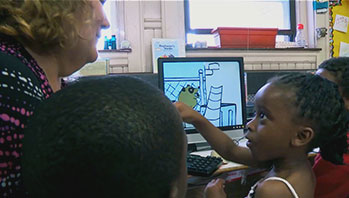- artificial and real flowers and plants
- artificial
- felt
- leaves
- plant
- plastic
- real
- stem
MA Standards:
English Language Art/Speaking and Listening/SL.PK.MA.2 Recall information for short periods of time and retell, act out, or represent information from a text read aloud, a recording, or a video (e.g., watch a video about birds and their habitats and make drawings or constructions of birds and their nests).
Head Start Outcomes:
Social Emotional Development/Self-Regulation Follows simple rules, routines, and directions.
PreK Learning Guidelines:
English Language Arts/Language 4 Engage in play experiences that involve naming and sorting common words into various classifications using general and specific language.
Artificial and Real Plants

© Commonwealth of Massachusetts, Department of Early Education and Care. All rights reserved.
Skill Focus: Compare and Contrast, Vocabulary
Provide children with some artificial plants to observe and describe using their senses of sight, smell, and touch. Invite children to compare the artificial plants to real plants and flowers, noticing how each one looks, smells, and feels. Introduce vocabulary such as smooth, rough, soft, hard, textured, plastic, and felt as you record children’s observations.
- Encourage children to think about other differences between real and artificial plants, for example, what they need and whether or not they grow and reproduce.
- Invite children to think about times when people might want artificial plants instead of real ones by asking questions such as, “Which ones would be easier to take care of and why do you think so? Which ones would last longer and why do you think so?
- Compare using artificial plants to using other human-made objects, such as using artificial food in the dramatic play area. Ask, Why don’t we use real food?
